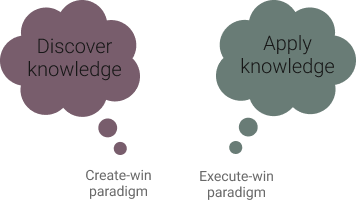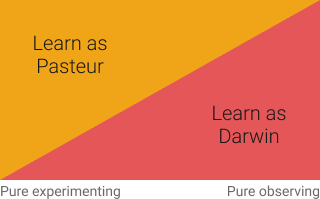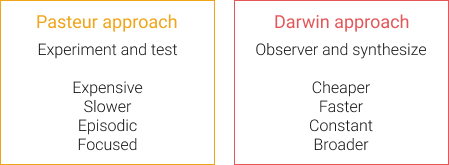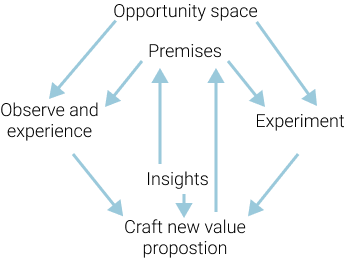Organizational Learning for Innovation: Why is it different?
August 2021 Prof. Antonio Davila / Daniel Oyon
When markets and societies are constantly offering opportunities to craft new value propositions for customers and citizens, organizations need to be as good at innovation as they are at execution. Yet, an innovation mindset is at odds with an execution mindset. This dichotomy is best reflected in their interpretation of learning.
In this note, we argue that learning for innovation is different from the traditional learning required for execution. When efficiency and optimizing dominates management, learning takes two forms. First, learning is about transferring knowledge. Kids learn to multiply and managers learn accounting. Both are bodies of knowledge that a person acquires. This knowledge transfer is the basis of the traditional concept of organizational learning, where knowledge is uploaded in a database for others to use. Second, learning is about mastering a skill like riding a bike or public speaking. This learning by doing benefits from practice. In real life, any activity, whether learning accounting or public speaking combines both types of learning, albeit in different proportions.
Learning for innovation is about discovery; facing uncertainties and taking actions to reduce them. This learning is not about optimizing processes or using resources more efficiently, but about discovering opportunities and designing value propositions to take advantage of them. It also takes two forms. Learning as Darwin builds on carefully observing to inspire new perspectives that uncover opportunities. It reflects how Darwin built his theory of evolution, observing and coding his experiences during five years across the southern hemisphere. Learning as Pasteur relies on experiments to reduce uncertainty. Pasteur discovered the role of microorganisms in diseases and the benefit of vaccines through carefully designed experiments.
Learning for innovation is messy, with many dead ends and multiple efforts unrelated to the final solution—hundreds of pages of observations that happen to be irrelevant and hundreds of experiments that fail. Yet, organizational learning in dynamic environments is about discovering opportunities; those organizations that fail to learn and stay anchored to their old models are easy preys to those that know how to learn for innovation.
Organizational Learning for Innovation: Why is it different?
Technologies across multiple disciplines are creating a growing number of opportunities, most of them still shaping themselves. For instance, quantum computing attracts not only large technology companies but also countless startups. Yet, the applications that these companies envision today are a tiny piece of what will be possible in the future. We know there are many unknown unknowns to be discovered as quantum computing moves forward and different business models are tested, discarded, and become platforms for further progress.
In the same way, innovative business models are constantly emerging with different fortunes. Technologies enable value propositions impossible a few years ago. Yet, the main force is the billions of people, mostly in Asia, that have joined the market economy and have more than doubled human ingenuity. The result is a countless stream of new value propositions, new ways to organize value creation, and constant threats to incumbents that want the world to stay put.
Innovation in business is about leveraging the complexity of markets and societies to discover emerging opportunities and build, mostly through smart trial and error, a value proposition around them. Startups are organizations designed to innovate; their growing relevance over the last twenty years reflects the increasing complexity of environments. Yet, leading incumbents are arduously exploring how to develop innovation capabilities; whether corporate venture capital, incubators, hackatons, skunk works, or design thinking training courses; they are working hard to find the management principles of innovation.
An informative definition of startup is an organization looking for a viable and sustainable business (or social) model. Because traditional performance metrics—profits, return measures, or enterprise value—do not work for a group of people searching for a value proposition, the metric of startup progress is learning: how much has this group of people learned.
Yet, what is learning when you need to innovate rather than optimize?
Learning for Execution
When the name of the game is execution, managers look for ways to have their organizations be more efficient. Their objective is to maximize the returns on the resources they have been endowed with. When uncertainties in markets and societies were about political turmoil and economic crises (and booms), organizations best at predicting these cycles, planning for them, and executing were the winners. In this “old normal,” technologies followed smooth roadmaps; revolutions were sparse and limited to specific industries. Business models evolved incrementally with success accruing to organizations best at execution.
Learning for execution is aligned with learning as most of us understand it. Going back to our learning years, we learned two different ways. First, learning was about knowledge transfer. The teacher at school taught us how to add and multiply, geography and history. Organizational learning—a concept that came into management at the turn of the 21st century—was about sharing (and transferring) knowledge: someone knows how to improve a manufacturing process or a selling pipeline and shares this knowledge for others to learn and apply it.
The other type of learning was learning through practice, also referred to as learning by doing. This is how we learn to ride a bike, negotiate, and public speaking. We learn a specific skill. The more we do it, the better we become at it. Learning happens as we repeat the activity. Yet, learning curve effects are such that at some point, the incremental learning becomes very small.
Any learning combines knowledge transfer and practice in different proportions. While multiplying or accounting is mostly about learning concepts and relationships, practice helps to get better at it. Similarly, learning to negotiate is mostly about negotiating repeatedly, but it benefits from having a conceptual framework.
Execution is about learning by doing and mastering a body of knowledge that organizations apply to optimize processes. Managers learn about accounting, logistics, incentive systems’ design, and sales techniques. They learn about negotiation, communications, and team dynamics. Management programs focus on these two types of knowledge. The better the organization at learning, the more knowledge and skills it can deploy to improve execution.

Learning for Innovation
Innovation is a different management paradigm. It is not about optimizing, although it plays a role, but about discovering. Startups search for viable business models that they can then scale. The opportunity is out there, but it needs to be discovered and crafted into value.
Innovation is about advancing without knowing where the path leads. It is full of dead ends and activities that make sense but have no definite purpose. It is about reducing the uncertainties of the unknown. The higher the uncertainty, the more dead ends—efforts that lead nowhere; efforts that, from an efficiency perspective do not add value, yet feed learning. Thomas Edison and his team went through more than 6,000 materials before finding the right filament for bulbs. Pharmaceutical researchers test over one million molecules to find the one that is both active and has low toxicity. Innovation drives managers with an execution mindset crazy: experiments that lead nowhere simply destroy value. From an execution mindset, Edison wasted the resources of 5,999 experiments.
Taking an execution mindset into innovation is akin to evaluating a painter by the amount of paint used in her masterpieces. Execution measures dimensions of performance that are secondary to innovation.
Learning plays a crucial role in innovation, much more central than its role in execution. As we mentioned before, the main performance dimension in startups is their rate of learning.

Yet learning for innovation is different from transferring knowledge and mastering a set of skills. These two types of learning are relevant, but not core. Learning for innovation is learning as scientists learn. Scientists have a strong knowledge base (and knowledge transfer has played a role) and from this base, they explore uncertainty to create new knowledge. Curious managers have a strong knowledge of markets and technologies and, from this base, they explore market forces to spot opportunities that can become sources of value.
Scientists learn in two ways, through experiments and through observation. The first one is learning as Pasteur and the second is learning as Darwin. Both scientists achieved amazing discoveries. Pasteur put forward the theory of microbes as the cause of many diseases. Darwin proposed the theory of evolution. Both of them associated ideas that were unrelated at the time, attracting strong criticism from contemporaries. Other French scientists constantly challenged Pasteur at the Academy of Sciences in Paris; while Darwin’s theory is even challenged today.
Both met dead ends and had to backtrack. They came up with hypotheses that they had to reject and revaluate. They were curious and attentive to unexpected findings. They had a deep understanding of the state of the art of their fields of knowledge and constantly interacted with peers to gather knowledge and be challenged.
Organizational learning for innovation combines these two types of learning: through experiments and through observation. Managers with an innovation mentality go around actively looking, gathering data, recording experiences, doing experiments, reading about the observations and experiments of others. They share these data and work in teams. They are interested in discovering how the world is changing, how the interaction of market and social forces creates new opportunities to generate value. As in any process of discovery, luck exists but, as Pasteur said, it favors the prepared mind.

Learning as Darwin
Charles Darwin, born in 1809, was not a brilliant student. Studying medicine like his father, he became interested in natural history and geology. His mentor, John Henslow, suggested him to be the naturist on the HMS Beagle, a ship tasked with doing a hydrographic survey of the southern hemisphere. The expected two-year trip lasted five years. When he embarked, he was knowledgeable of the latest idea on botany, geology, and zoology.
During the trip, he observed carefully, writing each day his observations on a diary and collecting samples that he dutifully shipped back to England at every stop. He survey the geology of the West Africa coastline, explored Argentina’s Pampa with the gauchos, collected fossils in the coast of Chile, and sent back samples from Galapagos (a visit that he first described as uneventful).
He returned to England in 1836, never to leave the island again. At his return, he began analyzing all his records and samples, relying on experts whenever he needed them. It was then when the small differences among the birds coming from different Galapagos islands caught his attention. As Darwin went through the material, contrasted it with experts, listen carefully to new ideas and discoveries, and ran experiments with plants and insects; the theory of evolution took shape. It was published in 1859, 23 years after Darwin’s trip.
Darwin crafted his theory of evolution through careful observation. Hundreds of pages of notes, countless samples, experiments at home, and constantly in touch with experts across various fields. The raw material was large, and probably only a small percentage of what he observed became relevant to his theory; yet, as he was collecting data, he did not know what would be relevant. Learning through observation is inefficient, yet without it, Darwin would not have discovered evolution.

Learning as Pasteur
Louis Pasteur was born in 1822 and a contemporary of Darwin. He began his career as a chemist and he always thought of himself as such, although his great contribution was in microbiology. His early studies in crystallography explained polarized light, before he moved into the chemistry of biological processes. He discovered that microorganisms caused the fermentation of wine, beer, and milk, rather than the combination of substances, at the time referred to as spontaneous generation. These microorganisms could be killed through a process that we now call (in his honor) pasteurization. He applied his discovery of microorganisms to a disease that plagued silk worms before extending it to diseases affecting mammals and humans like rabies. He discovered vaccination, inoculating people with attenuated versions of the microorganisms to protect them against these maladies. Through all his work, a group of fellow scientists constantly challenged his findings, dismissing him as having no medical training.
Pasteur identified interesting yet challenging fields to explore. Still, he was best at experimenting. He spent countless hours designing and running experiments in his laboratory, paying attention to every small detail. Most of them failed and opened new questions that he would address in his subsequent experiments. He would take copious notes on each one to understand what deviated from expectations. When they failed, he wrote “erroneous.” He was critical, anticipating what his challengers would argue.
His approach to learning relied on the scientific method: understand existing knowledge and its failures to explain reality, synthesize arguments into premises and hypotheses that then he would test with experiments. When they failed, he would review his arguments and the steps in the experiments; when they succeed, he would progress in his discovery of how nature works.

Organizational Learning for Innovation
Learning is at the core of innovation; it is the main performance measure to gauge startups—the organizations designed to innovate. Yet, it is not learning as we traditionally think of it: transferring knowledge and developing skills. It is about observation, experiences, and experiments. It is about gathering hundreds of pages of observations to use just a few and running dozens of experiments to have one that works as expected. An execution mentality would find this learning inefficient. Yet, an organization will not “see” opportunities emerging in the market using traditional learning; this type of learning is not designed for discovery.

Learning for innovation benefits from having a method. First, much like Pasteur, identify an attractive opportunity space where market dynamics are likely to open up opportunities. Innovation does not start with an idea, but with an opportunity space. In the same way, interesting research does not start with a potential solution, but with a smart question (i.e. an interesting opportunity space).
Second, rather than rush to a solution, devote time to observe, experience, and experiment. Gather raw material, better if various people are involved as to have a diverse set of points of view. Most of this material will go to waste, but the seed of an opportunity is there. Darwin did so for five years and then it took him another 23 to shape his theory.
Third, this raw material inspires new arguments, new perspectives about how to create value for the world. Without this raw material, as Pasteur often said, discovery is about beliefs, opinions, superstition, and myths. In a learning organization for innovation, apparent failures are part of the process of discovery. Every argument that brings together observations in a new way or interprets the outcome of experiments is a step in the stairs of knowledge: a step up that lets you see opportunities that you could not see before. Only through gathering, analyzing, and confronting this raw material, the organization “sees” opportunities before competitors.
Fourth, discovery never stops. There are always new opportunities, new evidence that challenges existing assumptions. In environments where forces are constantly shaping the contours of markets and societies, the sure way to fail is to dismiss learning for innovation.
Today’s markets and societies behave much like the scientific fields that Darwin and Pasteur faced. Creators—entrepreneurs and innovators—learn as Darwin and Pasteur (and today’s scientists) did. They identify an opportunity space, rich in dynamism. They do not accept current structures as given, but challenge them. They carefully observe and experience, with an open and curious mind: knowing that opportunities are awaiting to be discovered. They work in teams to get the diversity needed to capture the many dimensions of uncertainty. They purposefully get together to synthesize this raw material and explore insights. Finally, when they identify an opportunity, they work hard to craft a value proposition around it.
Steps in Learning for Innovation
- Define an opportunity space.
- Observe, experience, and experiment.
- Generate insights—opportunities emerging in markets and societies.
- Detail the uncertainties of the insights into premises—hypotheses for the insight to be valuable. If rejected, the insight has to pivot.
- Craft a new value proposition to take advantage of the refined insight; what premises need to hold for this value proposition? If a premise is rejected, the value proposition has to pivot.
